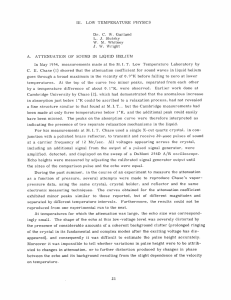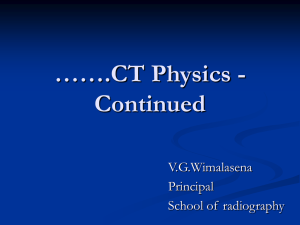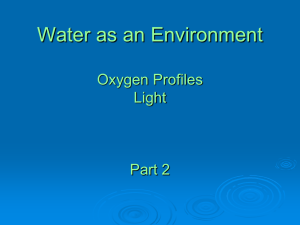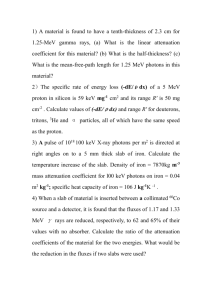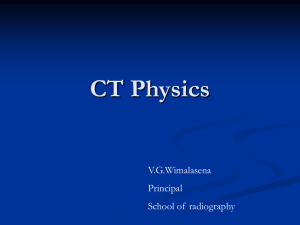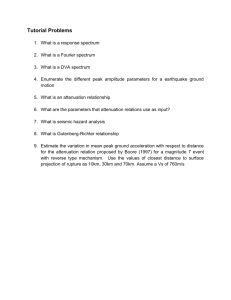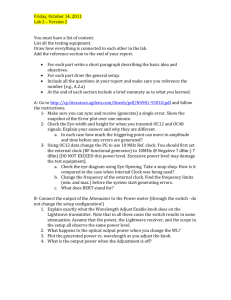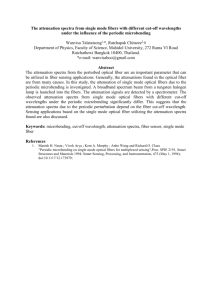III. LOW TEMPERATURE PHYSICS L. J. Slutsky
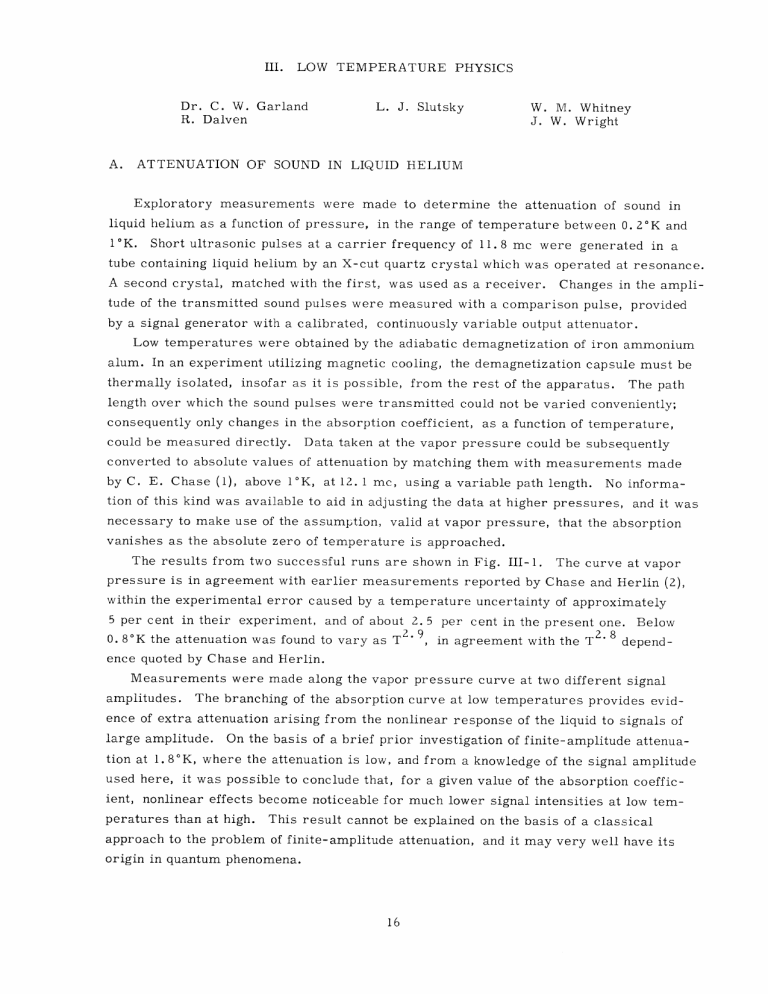
III. LOW TEMPERATURE PHYSICS
Dr. C. W. Garland
R. Dalven
L. J. Slutsky W. M. Whitney
J. W. Wright
A. ATTENUATION OF SOUND IN LIQUID HELIUM
Exploratory measurements were made to determine the attenuation of sound in liquid helium as a function of pressure, in the range of temperature between 0. 2 0 K and
1 K. Short ultrasonic pulses at a carrier frequency of 11. 8 mc were generated in a tube containing liquid helium by an X-cut quartz crystal which was operated at resonance.
A second crystal, matched with the first, was used as a receiver. Changes in the amplitude of the transmitted sound pulses were measured with a comparison pulse, provided by a signal generator with a calibrated, continuously variable output attenuator.
Low temperatures were obtained by the adiabatic demagnetization of iron ammonium alum. In an experiment utilizing magnetic cooling, the demagnetization capsule must be thermally isolated, insofar as it is possible, from the rest of the apparatus. The path length over which the sound pulses were transmitted could not be varied conveniently; consequently only changes in the absorption coefficient, as a function of temperature, could be measured directly. Data taken at the vapor pressure could be subsequently converted to absolute values of attenuation by matching them with measurements made by C. E. Chase (1), above 1oK, at 12. 1 mc, using a variable path length. No information of this kind was available to aid in adjusting the data at higher pressures, and it was necessary to make use of the assumption, valid at vapor pressure, that the absorption vanishes as the absolute zero of temperature is approached.
The results from two successful runs are shown in Fig. III-1. The curve at vapor pressure is in agreement with earlier measurements reported by Chase and Herlin (2), within the experimental error caused by a temperature uncertainty of approximately
5 per cent in their experiment, and of about 2. 5 per cent in the present one. Below
2.9
0. 8°K the attenuation was found to vary as T , in agreement with the T
2. 8 dependence quoted by Chase and Herlin.
Measurements were made along the vapor pressure curve at two different signal amplitudes. The branching of the absorption curve at low temperatures provides evidence of extra attenuation arising from the nonlinear response of the liquid to signals of large amplitude. On the basis of a brief prior investigation of finite-amplitude attenuation at 1. 8'K, where the attenuation is low, and from a knowledge of the signal amplitude used here, it was possible to conclude that, for a given value of the absorption coefficient, nonlinear effects become noticeable for much lower signal intensities at low temperatures than at high. This result cannot be explained on the basis of a classical approach to the problem of finite-amplitude attenuation, and it may very well have its origin in quantum phenomena.
(III. LOW TEMPERATURE PHYSICS)
VAPOR PRESSURE
S10-
S8.0
05-
ATMOSPHERES
13 ATMOSPHERES
18.3 A
0 0.1 0.2 0.3 0.4 0.5 0.6 0.7 0.8 0.9
TEMPERATURE (*K)
1.0
Fig. III-1. Attenuation of sound in liquid helium under pressure.
An interesting feature of the (low-amplitude) curve taken at vapor pressure is a change in the power law occurring at about 0. 4
0
K. Chase and Herlin found a similar change in the slope of their curve at 0. 3 0 K. In view of the fact that they used a somewhat longer path length, the present results are consistent with their suggestion that the effect might be connected with the rapid increase of phonon mean-free-paths with decreasing temperature. The increase in the power law should occur at a higher temperature for a shorter path length, as is observed.
A log-log plot of the curve taken at 8. 0 atmospheres shows that the attenuation varies as T A small increase in the power law, not evident in the figure, occurs at 0. 4°K.
Since the number of phonons per unit volume decreases rapidly with increasing pressure, with a consequent increase in the mean-free-path, we might have predicted that the increase in slope would occur at a higher temperature at this pressure than at vapor pressure. Unfortunately, the scatter in the data at low temperatures is a sizeable fraction of the attenuation itself, which is small at this pressure, and it is possible that the apparent change in power law is not significant. Nevertheless, the fact that there is clearly no other knee in the curve at higher temperatures appears to be inconsistent with the simple phonon mean-free-path interpretation of the effect at vapor pressure. The warm-up times for the demagnetizations at 13 and 18.3 atmospheres were, unfortunately, too short to permit the taking of reliable data in the temperature range from approximately 0. 6°K to 0. 8°K; hence the experimental scatter in this region is quite large.
These measurements, therefore, throw little light on the problem, although they do indicate roughly that the attenuation falls to zero much more rapidly than T
3
(III. LOW TEMPERATURE PHYSICS)
Measurements taken above 0. 8 0
K are reliable at all four pressures, however, and at these temperatures the attenuation can be discussed as a function of pressure.
According to Khalatnikov (3), the absorption coefficient (a) is given for liquid helium, as well as for ordinary liquids, by the expression
2
2pc where a is the angular frequency, p the density, c the velocity of sound,
Tr the coefficient of ordinary (shear) viscosity, and t the coefficient of second viscosity, containing the relaxation effects. It is known that, above 1°K, the attenuation calculated from the shear viscosity alone is an order of magnitude smaller than the measured value, so that is the dominant term in the expression in parentheses. The attenuation (a) has a certain substantial pressure dependence arising solely from that of the factor (l/pc3), which is of little interest here. We eliminate it by calculating instead the quantity a' = 2pc3 a/w .
Values of a', plotted in Fig. III-2, are seen to decrease approximately exponentially with pressure.
The only theoretical discussion of the attenuation of sound in liquid helium, based on a definite microscopic picture of the liquid, is that of Khalatnikov (4), who calculates relaxation times governing the anomalous attenuation from a consideration of collisions between the elementary excitations of the liquid, phonons and rotons. Unfortunately, he finds it necessary to introduce an adjustable parameter into the theory in order to make any kind of quantitative approach to the problem; therefore it is not possible to calculate the pressure dependence of his results. With a suitable choice for the value of the parameter, Khalatnikov's theory describes the temperature dependence of the attenuation at vapor pressure down to 1°K, but below that temperature it breaks down n
0
15.0
1.20- a
0o
0.80-
\o
T 0oo0K
\discussed and predicts an attenuation that falls to zero
3 much more rapidly than T , vanishing almost completely (5) at 0. 6
0
K.
In the neighborhood of the relaxation peak, the present results can at least be qualitatively from the point of
0.60
0
Fig. 111-2.
\
5
10 5
PRESSURE (ATMOSPHERES)
20
\
25
Pressure variation of normalized attenuation. view of the specific mechanisms on which
Khalatnikov bases his calculations-inelastic phonon-phonon and phonon-roton collisions.
A noticeable feature of the data is the increase, with increasing pressure, of the temperature at which the maximum attenuation occurs. One might infer from this
(III. LOW TEMPERATURE PHYSICS) result that the relaxation times of the elementary collision processes are increasing with pressure. This is the behavior to be expected from phonon-phonon interactions.
Phonon-roton interactions, however, would produce the opposite effect, since the number of rotons per unit volume increases with pressure, and the phonon-roton meanfree-paths are determined essentially by the roton density. The present results are not inconsistent with the interpretation that both processes are at work; their net result is to reduce the strength of the relaxation, with the phonon-phonon interaction having the dominant influence in shifting the temperature of the relaxation peak.
It is hoped that experiments, now under way, for the purpose of following up some of the problems presented by these preliminary results and extending the measurements to 2 mc and 6 mc, will help to define more clearly the theoretical problem that wlll have to be solved if the behavior of the attenuation is to be understood at these temperatures.
A more detailed account of the experiment described above can be found in reference 6.
W. M. Whitney
References
1. C. E. Chase, Proc. Roy. Soc. (London) A220, 116 (1953).
2. C. E. Chase and M. A. Herlin, Phys. Rev. 97, 1447 (1955).
3. I. M. Khalatnikov, J. Exp. Theor. Phys. USSR, 23, 21 (1952).
4. I. M. Khalatnikov, J. Exp. Theor. Phys. USSR, 20, 243 (1950).
5. C. E. Chase (private communication).
6. W. M. Whitney, Ph. D. Thesis, Department of Physics, M. I. T., 1956.
